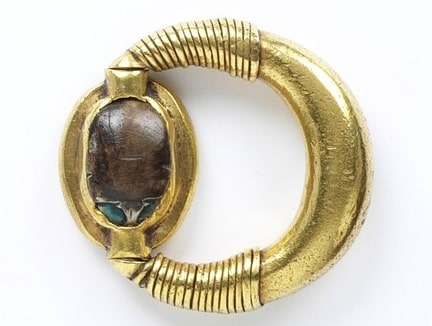Ancient and Classical Rings
Ancient Egyptians are known to have worn scarab rings, carved from a variety of stones including lapis lazuli, amethyst, rock crystal and turquoise, threaded simply by a silver or gold wire. They were often engraved on the flat side of the scarab with decorative hieroglyphs, protective symbols, or titles; with a simple swivel, the function of both signet and amulet were combined. During the period of the New Kingdom, (1559-1085 B.C.) Egyptian goldsmiths had progressed to casting all metal stirrup-shaped rings bearing the royal cartouche. These rings served not only as visible symbols of rank and power but as means to authenticate documents. Egyptians wore rings as signets or for religious and talismanic purposes and, although the materials were carefully worked and pleasing arrangements of stones and designs are evident, they were worn for a purpose rather than as mere decoration.
The ancient Greeks and Romans wore rings for a variety of different purposes, including purely ornamental ones. Scarab rings were worn by the Greeks as were signet rings engraved with motifs from nature and figures from mythology and literature. Bezels set with gems prized for their beauty, rarity and talismanic properties were worn, as were plain gold rings. Rings could also be ornately worked in wire, filigree and intricate pierced work, (opus interrasile).
In early Rome, during the Roman Republic, the first rings were made of iron and served as seals. The right to wear gold rings, the jus annuli aurei, was at first accorded only to senators and only while serving as ambassadors of the Republic. In time the right to wear rings of gold was awarded to all civilians. During the later years of the Roman Empire, both men and women came to wear heavy gold rings set with rare and costly gems in ever more conspicuous displays of wealth and status. While it had once been rare to wear more than one ring, by the first century AD each finger might be laden with multiple adornments.
The Greeks used rings as tokens of affection and love, frequently engraved with appropriate symbols such as depictions of Eros or Aphrodite. The custom of exchanging rings as tokens of betrothals, however, is believed to have originated with the Romans. Jewelry historian Diana Scarisbrick writes:
Since it was customary to exchange rings to mark the agreement of a business contract, so a ring, the annulus pronubu, was given as a pledge of engagement to marriage-though, unlike the wedding rings of later periods, it did not signify that the union was permanently binding. According to Pliny this ring was originally of iron without a gem, but by the 2nd century AD all who could afford to use gold did so.2
Roman wedding rings often featured the image of two right hands clasped in symbolic representation of marriage and fidelity called dextrarum iunctio in Latin. In Roman symbolism, the right hand was considered sacred to Fides, the deity of fidelity – the motif reappears in the Middle Ages as the fede ring. According to ancient texts, the betrothal ring was worn on the fourth finger of the left hand in the belief that this finger had a vein, the vena amoris that flowed directly to the heart. Another motif used for betrothal rings was the marriage knot or knot of Hercules, a simple and symbolic design of two intertwined ropes that is probably the origin of the phrase “tying the knot.”
Perhaps the ring style most associated with the Romans was the signet ring. Diana Scarisbrick notes that the wealth of Rome attracted the best and most skilled artists to engrave and set gems. Signet rings were used to seal official documents, with gemstone intaglios frequently engraved with the wearer’s portrait. They were also worn for purely decorative purposes and were often large and ornate. Aspects of everyday life, figures of gods and rulers and portraits of poets and philosophers were among the popular themes. Love was another favored theme and intaglios featuring the heads of lovers face to face were used in signet rings as marriage rings.



